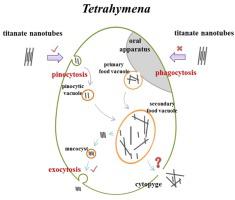Aquatic Toxicology ( IF 4.1 ) Pub Date : 2021-02-25 , DOI: 10.1016/j.aquatox.2021.105790 Ren Kong , Qian Sun , Shiyang Cheng , Jie Fu , Wen Liu , Robert J. Letcher , Chunsheng Liu

|
The potential exposure of titanate nanotubes (TNTs) to wildlife and humans may occur as a result of increased use and application as functional nanomaterials. However, there is a dearth of knowledge regarding the pathways of uptake and excretion of TNTs and their toxicity in cells. In this study, three strains of the Tetrahymena genus of free-living ciliates, including a wild type strain (SB210) and two mutant strains (SB255: mucocyst-deficient; NP1: temperature-sensitive “mouthless’’), were used to study the pathways of uptake and excretion and evaluate the cytotoxicity of TNTs. The three Tetrahymena strains were separately exposed to 0, 0.01, 0.1, 1 or 10 mg/L of TNTs, and cells were collected at different time points for quantification of intracellular TNTs (e.g., 5, 10, 20, 40, 60, 90 and 120 min) and evaluation of cytotoxicity (12 and 24 h). TNT contents in NP1 and SB255 were greater or comparable to the contents in SB210 while exposure to 10 mg/L TNTs in 120 min. Furthermore, exposure to 10 mg/L TNTs for 24 h caused greater decreases in cell density of NP1 (38.2 %) and SB255 (36.8 %) compared with SB210 (26.5 %) and upregulated the expression of caspase 15 in SB210. Taken together, our results suggested that TNT uptake by pinocytosis and excretion by exocytosis in Tetrahymena, and the exposure could cause cytotoxicity which can offer novel insights into the accumulation kinetics of nanotubes and even nanomaterials in single cell.
中文翻译:

四膜虫属自由活动纤毛虫的三种染色剂中钛酸酯纳米管的吸收,排泄和毒性
钛酸酯纳米管(TNT)对野生生物和人类的潜在暴露可能是由于越来越多地使用和应用为功能性纳米材料而导致的。然而,关于TNT的摄取和排泄途径及其在细胞中的毒性的知识尚缺乏。在这项研究中,使用了三个自由生活纤毛虫四膜虫属菌株,包括一个野生型菌株(SB210)和两个突变菌株(SB255:缺乏粘液囊藻; NP1:对温度敏感的“无嘴”),摄取和排泄的途径,并评估TNT的细胞毒性。三个四膜虫将菌株分别暴露于0、0.01、0.1、1或10 mg / L TNT,并在不同时间点收集细胞以定量细胞内TNT(例如5、10、20、40、60、90和120分钟)并评估细胞毒性(12和24小时)。在120分钟内暴露于10 mg / L TNT中时,NP1和SB255中的TNT含量大于或等于SB210中的含量。此外,与SB210(26.5%)相比,暴露于10 mg / L TNT中24小时导致NP1(38.2%)和SB255(36.8%)的细胞密度下降更大,并上调了SB210中caspase 15的表达。两者合计,我们的结果表明,四膜虫病中通过胞饮作用吸收了TNT,通过胞吐作用排出了TNT。,并且暴露可能会引起细胞毒性,这可以为单细胞中纳米管甚至纳米材料的累积动力学提供新颖的见解。











































 京公网安备 11010802027423号
京公网安备 11010802027423号